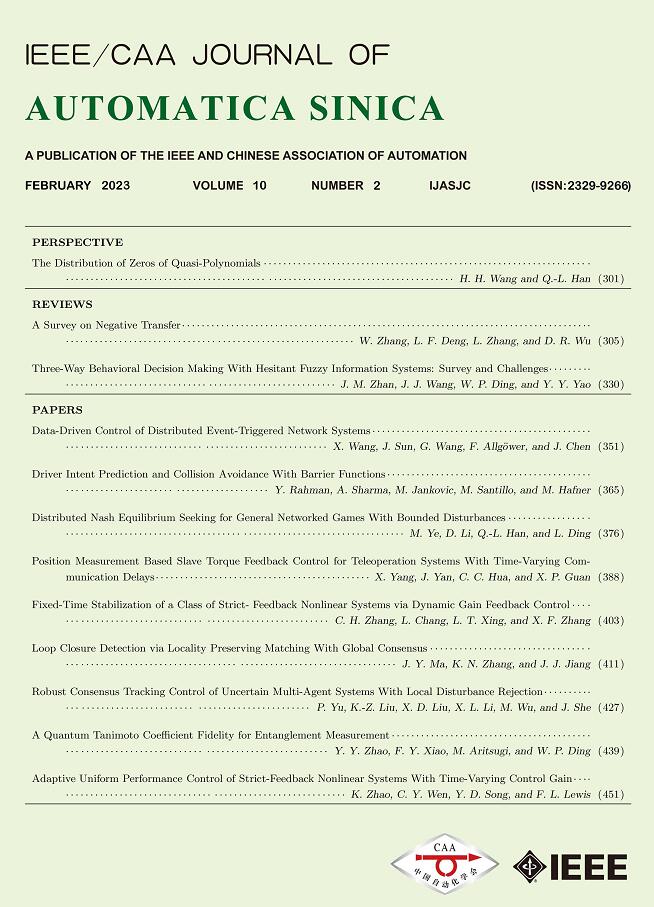 Volume 10
Issue 2
Volume 10
Issue 2
IEEE/CAA Journal of Automatica Sinica
| Citation: | Y. Lei, Y.-W. Wang, X.-K. Liu, and W. Yang, “Prescribed-time stabilization of singularly perturbed systems,” IEEE/CAA J. Autom. Sinica, vol. 10, no. 2, pp. 569–571, Feb. 2023. doi: 10.1109/JAS.2023.123246 |

| [1] |
S. P. Bhat and D. S. Bernstein, “Finite-time stability of continuous autonomous systems,” SIAM J. Control and optimization, vol. 38, no. 3, pp. 751–766, 2000. doi: 10.1137/S0363012997321358
|
| [2] |
B. Jiang, Q. Hu, and M. I. Friswell, “Fixed-time attitude control for rigid spacecraft with actuator saturation and faults,” IEEE Trans. Control Systems Technology, vol. 24, no. 5, pp. 1892–1898, 2016. doi: 10.1109/TCST.2016.2519838
|
| [3] |
Z. Gao and G. Guo, “Fixed-time sliding mode formation control of AUVs based on a disturbance observer,” IEEE/CAA J. Autom. Sinica, vol. 7, no. 2, pp. 539–545, 2020. doi: 10.1109/JAS.2020.1003057
|
| [4] |
B. Tian, Z. Zuo, X. Yan, and H. Wang, “A fixed-time output feedback control scheme for double integrator systems,” Automatica, vol. 80, pp. 17–24, 2017. doi: 10.1016/j.automatica.2017.01.007
|
| [5] |
Y. Hong, “Finite-time stabilization and stabilizability of a class of controllable systems,” Systems &Control Letters, vol. 46, no. 4, pp. 231–236, 2002.
|
| [6] |
A. Polyakov, D. Efimov, and W. Perruquetti, “Finite-time and fixed-time stabilization: Implicit lyapunov function approach,” Automatica, vol. 51, pp. 332–340, 2015. doi: 10.1016/j.automatica.2014.10.082
|
| [7] |
F. Lopez-Ramirez, A. Polyakov, D. Efimov, and W. Perruquetti, “Finite-time and fixed-time observer design: Implicit lyapunov function approach,” Automatica, vol. 87, pp. 52–60, 2018. doi: 10.1016/j.automatica.2017.09.007
|
| [8] |
H. Wang, W. Bai, and P. X. Liu, “Finite-time adaptive fault-tolerant control for nonlinear systems with multiple faults,” IEEE/CAA J. Autom. Sinica, vol. 6, no. 6, pp. 1417–1427, 2019. doi: 10.1109/JAS.2019.1911765
|
| [9] |
C.-H. Zhang and G.-H. Yang, “Event-triggered global finite-time control for a class of uncertain nonlinear systems,” IEEE Trans. Automatic Control, vol. 65, no. 3, pp. 1340–1347, 2019.
|
| [10] |
B. Zhou and Y. Shi, “Prescribed-time stabilization of a class of nonlinear systems by linear time-varying feedback,” IEEE Trans. Automatic Control, vol. 66, no. 12, pp. 6123–6130, 2021. doi: 10.1109/TAC.2021.3061645
|
| [11] |
Y. Song, Y. Wang, J. Holloway, and M. Krstic, “Time-varying feedback for regulation of normal-form nonlinear systems in prescribed finite time,” Automatica, vol. 83, pp. 243–251, 2017. doi: 10.1016/j.automatica.2017.06.008
|
| [12] |
B. Zhou, “Finite-time stabilization of linear systems by bounded linear time-varying feedback,” Automatica, vol. 113, p. 108760, 2020.
|
| [13] |
P. Kokotović, H. K. Khalil, and J. O’reilly, “Singular perturbation methods in control: Analysis and design,” SIAM, 1999.
|
| [14] |
A. R. Teel, L. Moreau, and D. Nesic, “A unified framework for input-to-state stability in systems with two time scales,” IEEE Trans. Automatic Control, vol. 48, no. 9, pp. 1526–1544, 2003. doi: 10.1109/TAC.2003.816966
|
| [15] |
H. Shen, F. Li, Z.-G. Wu, J. H. Park, and V. Sreeram, “Fuzzy-model-based nonfragile control for nonlinear singularly perturbed systems with semi-markov jump parameters,” IEEE Trans. Fuzzy systems, vol. 26, no. 6, pp. 3428–3439, 2018. doi: 10.1109/TFUZZ.2018.2832614
|
| [16] |
H. Wang, C. Yang, X. Liu, and L. Zhou, “Neural-network-based adaptive control of uncertain mimo singularly perturbed systems with full-state constraints,” IEEE Trans. Neural Networks and Learning Systems, 2021. DOI: 10.1109/TNNLS.2021.3123361
|
| [17] |
L. Ma, Z. Wang, C. Cai, and F. E. Alsaadi, “A dynamic event-triggered approach to H∞ control for discrete-time singularly perturbed systems with time-delays and sensor saturations,” IEEE Trans. Systems,Man,and Cybernetics: Systems, vol. 51, no. 11, pp. 6614–6625, 2020.
|
| [18] |
Z. Fu, W. Xie, S. Rakheja, and J. Na, “Observer-based adaptive optimal control for unknown singularly perturbed nonlinear systems with input constraints,” IEEE/CAA J. Autom. Sinica, vol. 4, no. 1, pp. 48–57, 2017. doi: 10.1109/JAS.2017.7510322
|
| [19] |
Y. Lei, Y.-W. Wang, I.-C. Morarescu, and R. Postoyan, “Event-triggered fixed-time stabilization of two-time-scale linear systems,” IEEE Trans. Automatic Control, 2022. DOI: 10.1109/TAC.2022.3151818
|